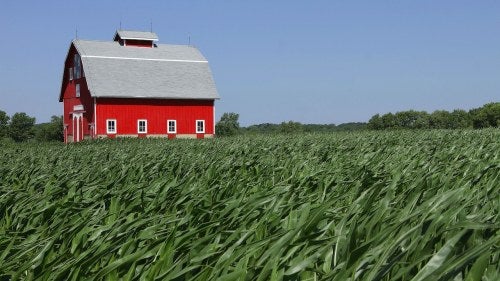How Cover Crops Could Help the Midwestern Agriculture Business

Cover crops help prevent soil erosion and can increase farmers’ yields — but, despite widespread use overseas, they haven’t caught on much yet in the Midwest.
As temperatures drop and winter approaches, many Midwesterners are planning for the holidays and eagerly awaiting the first snowfall. For the region’s farmers, though, winter means something else: the off-season, when their fields traditionally lie fallow.
The period between the harvest of one crop and the planting of the next can bring risks for the exposed farmland, from weed growth to soil erosion brought on by heavy snowfall. To combat these risks, a small but growing number of Midwestern farmers are turning to cover cropping, the practice of planting a secondary crop to protect a field from exposure during the off-season. Cover crops — typically low-maintenance plants like grasses or clover — aren’t intended for harvest or sale; they’re merely meant to cover and, in turn, to mitigate the risks that come with a fallow field.
“You basically are using it as kind of a temporary silo when you’re not having a cash crop in there,” Jonathan Coppess, a professor of agriculture law and policy at the University of Illinois Urbana-Champaign, told ChicagoGlobal.
While cover cropping in the Midwest has increased fourfold from 2011 to 2021, it still occurs on just a small percentage of the region’s 148 million acres of farmland.
That stands in stark contrast to the practice’s use in some farming regions overseas. Parts of Europe, for instance, use cover crops on almost all of their arable land due to stricter regulations. Coppess said more state and federal incentives could similarly increase uptake in the Midwest — though he also notes that, while the practice helps eliminate some risks, it also comes with risks of its own.
The Benefits — and Risks — of Cover Cropping
Preventing soil erosion is one of cover cropping’s main benefits. You may have seen soil erosion in action if you’ve ever driven past a field in winter and seen it covered in snow that’s flecked through with brown. That brown snow is created when the soil in a field erodes and leaches into the snow on top of it — and that erosion can cause a host of issues, from reducing the quality of the surrounding groundwater to decreasing crop yields. In the most severe cases, it can even make the land unfarmable.
Cover cropping can prevent that dangerous erosion, Coppess said, in addition to helping with weed suppression and preventing nitrogen — an essential nutrient — from washing away. As cover crops decompose, they also feed the other living organisms in the soil, creating an overall healthier ecosystem.
Because of these protective effects, cover cropping can increase the yields of a farmer’s primary, cash-driving crops, sometimes significantly. One 2019 study of the Midwest staple crops of corn and soybeans found that cover crops caused increases as high as 9.6% in corn and 11.6% in soybeans.
So, if cover cropping can benefit the environment and increase yields, why do so few Midwestern farmers use it?
Anna Morrow, program manager for the Midwest Cover Crops Council, told ChicagoGlobal that the additional resources needed to successfully use cover crops can be a deterrent for some farmers.
“Cover crops really require a change in management,” she said. Instead of using the off-season to simply plan ahead for next year, farmers using cover crops have a whole extra season of growth to contend with, which can require changes in everything from labor to pest control. “To do it well it requires looking at the farm practices as a whole, so farmers are a little reluctant because it’s a big undertaking, and there is some cost and risk associated with it.”
Coppess also spoke to that risk. Farming, he noted, requires careful, precise timing at each stage of the growing process, and cover cropping adds an additional element to account for. Taking even just a few days to plant a new cover crop could push back the timeline of planting and harvesting your cash crop — which could cause temporary decreases in yield while a farm adjusts to its new schedule.
To account for those costs and risks, Coppess said there needs to be more federal funding to incentivize farmers and protect them from the losses that could be incurred while they establish a cover cropping practice. Such government funding has already led to increased cover cropping in the past. National programs like the Environmental Quality Incentives Program, for instance, which invested $14 billion in conservation practices between 2010 and 2020, were correlated with an increase in Midwestern cover cropping from 1.8% to 7.2% between 2011 and 2021 — and Coppess believes that adjusting such programs could lead to further gains.
“I think a first really good and important step in redesigning [the Environmental Quality Incentives Program] would be, frankly, to boost the incentive for those kinds of risks to address the yield questions and concerns,” he said.
Cover Cropping Abroad
Cover cropping and other similar conservation practices are used all over the world, and in Europe, regulation has already helped the measures achieve substantial use.
The European Union has a robust set of environmental regulations that aim to mitigate farming’s environmental impact. The Nitrates Directive, first adopted in 1991, promotes certain farming practices — cover cropping included — to prevent nitrates from getting into surface water. Another more recent regulation, the Common Agricultural Policy, requires farmers with over 15 hectares of land to engage in at least one type of sustainable farming practice or be penalized. Each EU country chose for itself what kind of practices fulfilled that sustainability requirement, and many of them selected cover cropping as an option. Researchers say that policies like these are a significant reason why Europe has relatively high cover crop uptake. Cover crops were grown on 19% of Europe’s arable land in 2016, with some regions reaching up to 92%.
However, the EU’s ambitious — and compulsory — climate regulations have not come without pushback. Last summer, farmers across the continent protested proposed EU policies aimed at slowing warming. The protests succeeded in weakening many of the governing body’s environmental rules.
“Ours is a voluntary program, which I think is a good thing,” Morrow said of the U.S.’s cover crop incentives and rules. “But, when it’s regulated, there are some areas of the country and across the world that have a much higher percentage of cover crop takers” — which the Midwest Cover Crops Council believes is a worthy goal.
As the council’s mission statement says, increasing cover crop usage “will produce numerous ecological benefits,” all of which can help the Midwest maintain its status as a globally important agricultural region. “In an era where the Mississippi River Basin and Great Lakes watershed suffer from serious environmental degradation,” it continues, “this shift in agricultural systems can play a significant and positive role.”
This story first appeared in the ChicagoGlobal newsletter, a joint project of Crain's Chicago Business and the Chicago Council on Global Affairs.

